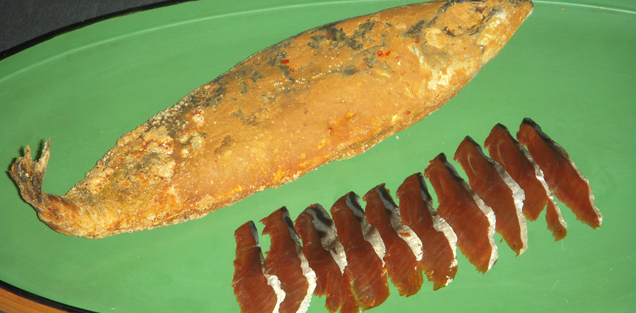Gourmand Dietary Culture
- TOP
- ESSAYS
- Gourmand Dietary Culture
- Fermented Mackerel
Fermented Mackerel
vesta No. 81
Fermented Mackerel [Heshiko]
In Obama City, Fukui Prefecture, there is the Wakasa Obama Food Culture Museum. Known across Japan as a "Food Town," Obama founded the first public Japanese food museum.
The museum doesn't only exhibit examples of Obama food culture, it also has a studio kitchen where people can try out cooking and preparing food. In the adjoining food shop "Seasons of the Beach," you can taste local home cooking made by women from the area, and new home cooking made from local Obama ingredients. Next time you go to Wakasa, I strongly encourage you to visit the museum. That's a message from Professor Gourmand, the honorary director general of the museum. And when you do go to Wakasa, come back with specialties like fried mackerel, pickled small red snapper [kodai-no-sasazuke], and fermented mackerel [heshiko].
Heshiko is made using mackerel, sardines, fugu, or other fish, pickled in brine and fermented bran. The areas along the Japanese coast in the Tohoku and Hokuriku regions that call it "fermented-bran pickled" [konukazuke or nukazuke] are many, but along the coast from Wakasa Bay to Tottori Prefecture it is called "heshiko."
Salt-pickled fish is coated in fermented rice bran, packed in a barrel, weighted down, and then covered in the salt brine that the fish had originally been pickled in. It is then left for a whole summer, until, after at least half a year fermenting and maturing, the heshiko is ready. As it's pickled fish, it keeps for a long time. During the fermenting process a proteinoid part of the fish flesh decomposes, producing peptide and separate amino acids. It is a product that is packed with the umami taste of glutamine. As heshiko is a coastal food, there are many people living in the Kansai and Osaka region who haven't heard of it. But at the end of the road that joins Obama to Kyoto, the "mackerel highway" [saba kaido], I have eaten heshiko. Whilst a student in Kyoto, I ordered heshiko at an izakaya. Heshiko is extremely salty, so roughly a ball of earwax-size amount is enough to have with a single cup of sake. It was my favorite cheap food and drink combination as a poor student.
Usually you get rid of the fermented bran, and lightly cook it. But what I discovered when I first visited Obama, was heshiko sashimi. The mackerel heshiko is finely sliced, rinsed in sake, and then eaten. The strong umami flavor that comes out within the saltiness goes well with nihon-shu. If you cover it in olive oil, balsamic, and your chosen herbs, it also works as an hors d'oeuvre with wine. Heshiko is not only good as a snack with sake, it can also be used in place of anchovies in a pasta sauce. Bran-pickled vegetables, like radish, were an invention of the Edo Period. From the Edo Period, rotary and rice hulling machines became standardized. With the machine hulling of brown rice to make white rice, vast quantities of rice bran were produced. This led to the production of fermented bran. Fermented-bran pickled fish was also certainly popularized in the Edo Period. I've researched fermented fish products across East and South East Asia, but Japan is the only country to pickle fish using fermented bran. Obama also has a type of mackerel fermented sushi [narezushi], made by re-pickling heshiko with rice.
When I eat heshiko my family usually scold me with: "how can you eat something so salty?" But, actually, according to the research of Professor Yoshiaki Akabane, Vice President of Fukui Prefectural University, and specialist in the science of marine food, heshiko and narezushi are actually good for the body. The peptides contained in heshiko and narezushi combat high blood pressure, prevent the growth of bad cholesterol, and increase good cholesterol (see Yoshiaki Akabane, "The Functionality of Traditional Food: The Example of Fermented Mackerel Foods like Heshiko and Narezushi," in The Future of Traditional Food [Domesu Publishing, 2009]).
Thanks to this research, I now have a reason to eat heshiko. Providing I don't eat so much as to risk having too much salt, it's actually good for my health!

